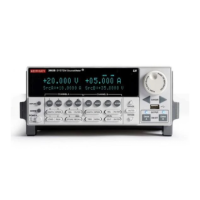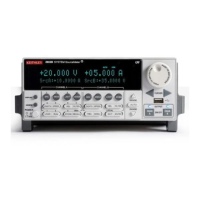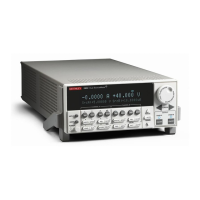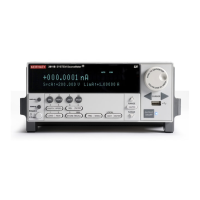14-10 Return to Section Topics 2600AS-901-01 Rev. B / September 2008
Section 14: System Expansion (TSP-Link) Series 2600A System SourceMeter® Instruments Reference Manual
Using the data queue for real-time communication
You cannot access the reading buffers or global variables from any node in a remote group while a
node in that group is performing an overlapped operation. You can use the data queue to retrieve
data from any node in a group performing an overlapped operation. In addition, the master node
and the group leaders can use the data queue as a way to coordinate activities.
The data queue uses the first-in, first-out (FIFO) structure to store data. Nodes running test scripts
in parallel can store data in the data queue for real-time communication. Each Series 2600A has
an internal data queue. You can access the data queue from any node at any time.
You can use the data queue to post numeric values, strings, and tables. Tables in the data queue
consume one entry. A new copy of the table is created when the table is retrieved from the data
queue. The copy of the table does not contain any references to the original table or any
subtables.
To add or retrieve values from the data queue and to view the capacity, see Section 19.
Copying test scripts across the TSP-Link network
To run a large script on a remote node, it is highly recommend that you copy the test script to the
remote node to increase the speed of test script initiation.
Use the code below to copy test scripts across the TSP-Link network. This example creates a
copy of a script on the remote node.
Note the following:
• The copy of the test script has the same name as the source
• Replace N with the number of the node that receives a copy of the script
• Replace myscript with the name of the script that you want to copy from the local node
-- Adds the source code from myscript to the data queue.
node[N].dataqueue.add(myscript.source)
-- Creates a new script on the remote node using the source code from
-- myscript.
node[N].execute(myscript.name..“ = script.new(dataqueue.next(),
[[“..myscript.name..“]])“)
Removing stale values from the reading buffer
The node that acquires the data stores the data for the reading buffer. To optimize data access, all
nodes can cache data from the node that stores the reading buffer data.
Running TSL code remotely can cause values in the reading buffer cache to become stale. If the
values in the reading buffer change while the TSL code runs remotely, another node can hold stale
values. Use the clearcache command to clear the cache.
The following code demonstrates how stale values occur and how to use the clearcache
command to clear the reading buffer cache.
Note the following:
• Replace N with the node number
• Replace G with the group number

